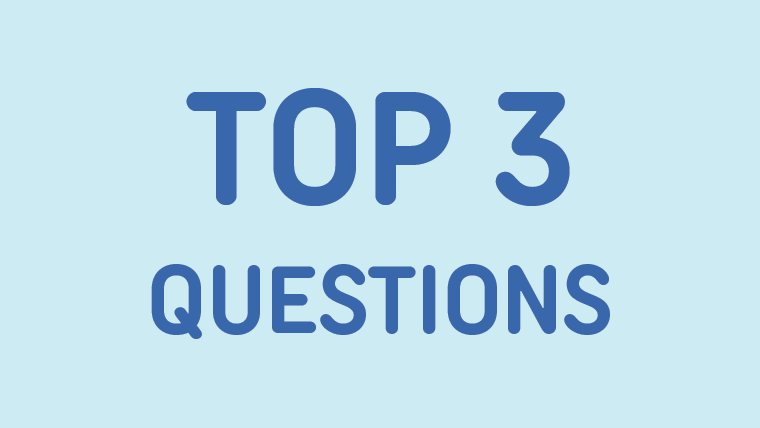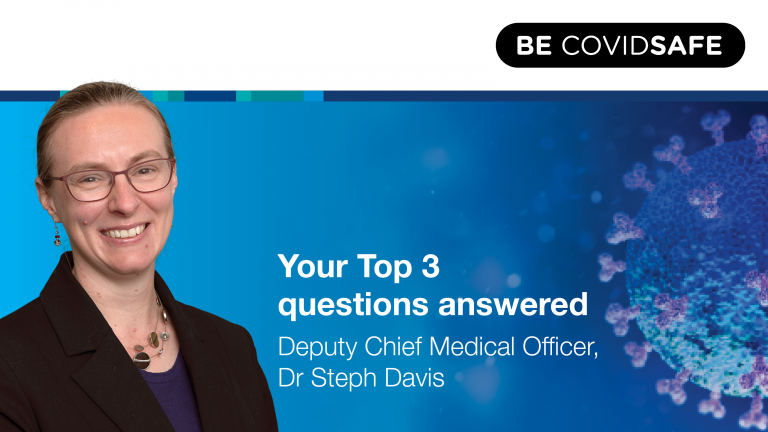
My name is Steph Davis I’m a Deputy Chief Medical Officer at the Commonwealth Department of Health. Thank you all for joining us for these top three questions today. Before I go any further I would just like to acknowledge that here in Canberra today I’m speaking from Ngunnawal country and I would like to pay my respects to the traditional custodians of this land and extend those respects to traditional custody and on the land of which others are tuning into this video from today and also to extend those respects to any Aboriginal and Torres Strait Islander people
who are watching or in the room with us today.
My shout out today is to all the carers in our community. It is Carers
Week this week. I found out today there are over 2.65 million carers in Australia. I can just say that it is an amazing job you are doing and I just want to thank you all for the amazing and ongoing support and love you give to those you care for. So, thank you.
So, the first question I got today is, what is the difference between vaccination and immunisation? And it’s a really good question. Because although the terms are often used interchangeably, they actually mean slightly different things. So, vaccination is the process by which we get the vaccine. They can be injected into your arm, or your leg if you were a baby, or it can be given orally like some vaccines are. Immunisation includes both the process by which we get the vaccine and also the process by which our body develops an immune response. So, what I mean by this, this really comes back to the basics of what the vaccine does. The vaccine primes our body so that if we come into contact with the disease, we are already ready to fight it. So, when you get a vaccine, it tells our body exactly what it shows our body how to recognise the disease when we come into contact with it. It primes it to fight the disease which means it will either stop us getting infected with the disease or stop us from getting
severely unwell with the disease. And when it is finished the process of telling our body how to fight it, that is the process of immunisation compared with vaccination, which is just getting the vaccine itself. So, coming back to the COVID-19 vaccine, vaccination of COVID-19 vaccine is getting it in your arm. Immunisation is the process by which your body develops an immune response to the COVID-19 disease and will stop you from either getting the disease and particularly stops you from getting really severely unwell from the disease or dying from the disease. As always, have to do my shout out here and remind everyone if you haven’t got your COVID-19 vaccine yet and you are able to do so, please book in as soon as you can. It’s really important both for you and for our community generally.
So, my second question today, is what is myocarditis and pericarditis and does the COVID-
19 vaccine cause these?
Myocarditis is the inflammation of the heart muscle. Pericarditis is inflammation of the thin sack
which surrounds the heart. So, both myocarditis and pericarditis have been linked to mRNA – containing vaccines. That is the Pfizer vaccine and the Moderna vaccine’s. They seem to
be particularly common or more common in males under the age of 30. So it sounds pretty scary when you talk about heart inflammation being linked to a vaccine but we need to keep a couple of things in context here. First of all, the vast majority of people who have had pericarditis or myocarditis
after receiving their vaccine have had very, very mild cases of the disease in which they recover completely, with no ongoing long-term effects. The second thing to remember is that these are
extremely, extremely rare complications. The overall rate amongst those who have received the Pfizer vaccine appears to be about 2.7 per 100,000 people, who get the vaccine. And this is the third point, which is the most important, is that this rate is much lower than the rate of pericarditis and
myocarditis from getting COVID-19 disease itself. The rate of that is about 11 per 100,000 people. So again, for the vast majority of people, the benefits of getting the vaccine are going to outweigh the potential risks of getting the vaccine. Really important to know again that these kind of safety signals are people are keeping a very close eye on them both in the Therapeutic Goods Administration, and ATAGI, the Australian Technical Advisory Group on Immunisation, meet regularly to discuss any kind of signals that could indicate any side effects or other kind of effects which are occurring due to the vaccine and take all of these into consideration in their ongoing recommendations.
Now, my third question today is, does the level of protection from COVID-19 vaccine weaken over time and does it matter?
Again, a really good question. So, the answer to this one is we don’t absolutely know at the
moment. I know that’s not a very satisfying answer but as with so many things in this pandemic we are learning as we go, and that is just the nature of a new disease. So, there are a couple more things to say about that. Look, there is a lot of research going on in this area. As I mentioned before, the
Therapeutic Goods Administration and ATAGI, the Australian Technical Advisory Group on Immunisation, are constantly looking at whether or not or how long protection from vaccines lasts and whether or not it means we need a booster shot. There is a lot of ongoing work looking at what is being done overseas and that is looking at both peoples immune response to the vaccine and also whether or not they actually get the disease after a period of time. You may have read or seen that 1/3 shot is being currently recommended for some Australians. This was a recommendation that came from ATAGI about a 1/3 shot being for those people who suffer from immunocompromised. There are various conditions that might lead you to being immunocompromised, things like receiving chemotherapy for cancer, some other conditions receiving very high-dose steroids and other particular medications or diseases that might could cause you to be immunocompromised and therefore not being able to mount that immune response. In response to the vaccine itself. A 1/3 shot is
been recommended for this group not as a booster but to bring their levels of protection up to that of the general Australian population. So it is really completion of the primary course that is, most of us get two shots for our primary course. People who are immunocompromised need three shots for the same level of protection, rather than being a booster in and of itself. In terms of boosters for the rest of the population, it’s really going to be a matter of watching this space
and it’s going to a matter of watching this space for a while. As to whether we will need a single booster, more than one booster or whether it’s going to turn into a annual or slightly less.
frequently than annual shot. For example, like the flu vaccines. So, that is my top three questions for today.
Thank you very much to everyone who has joined in. I hope this was helpful. Thank you particularly, to Linda who is always very patient with me and does such a great job of interpreting and hopefully I will see you all again soon.
Top 3 questions
- What’s the difference between a vaccine and immunisation?
- What is myocarditis and pericarditis, and does the COVID-19 vaccine cause it?
- Does the level of protection from COVID-19 vaccines weaken over time, and does that matter?







